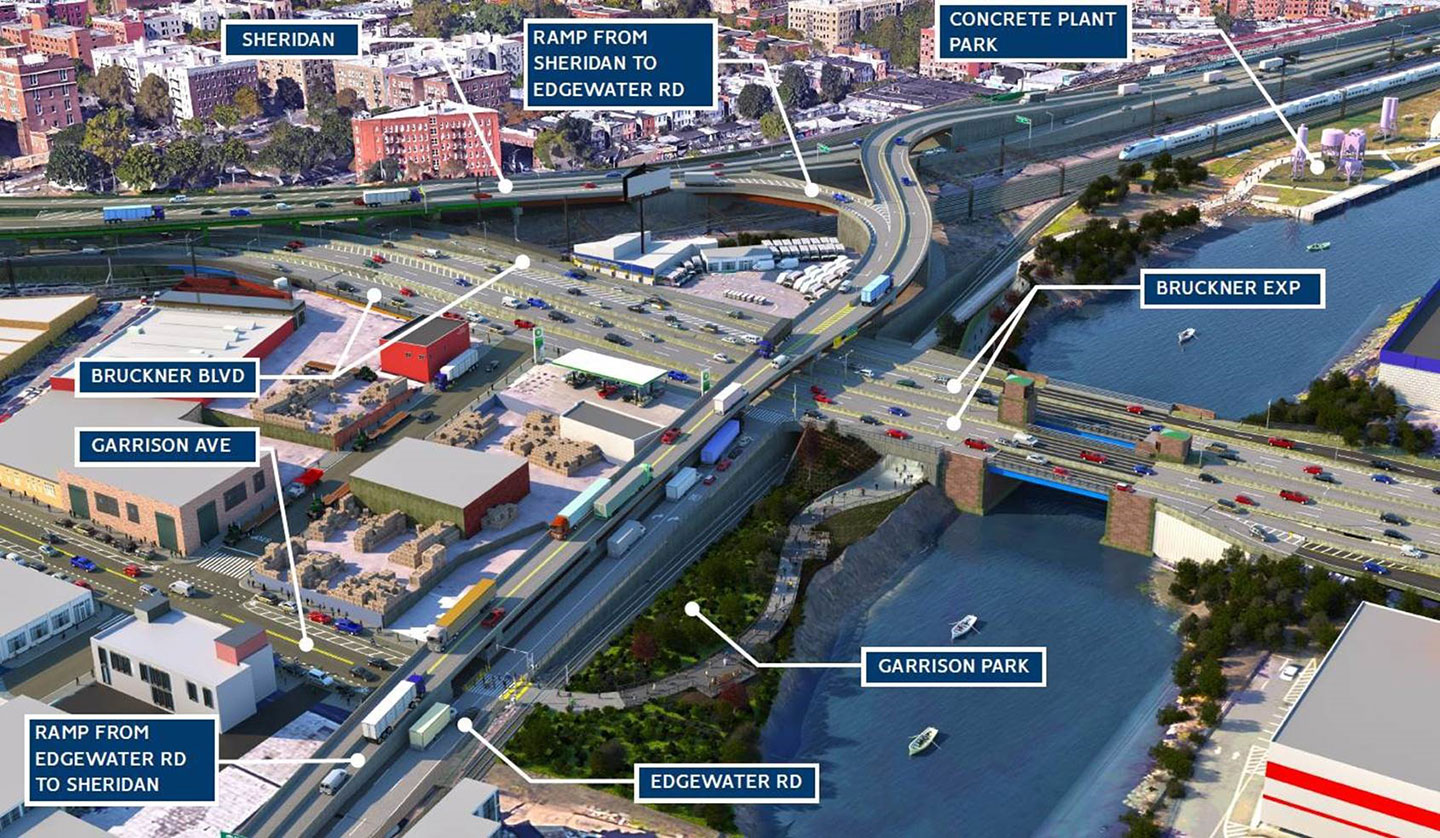Projects that either are being funded by the federal government or require federal permits follow the National Environmental Policy Act (NEPA), which is a federal regulation law that came into effect in 1970. Within NEPA, there are different levels of environmental documentation, and the highest, and often most complex, environmental documentation is what's called an environmental impact statement (EIS). This decision-making framework assesses the potential benefits as well as impacts of the project on the area in which the project is going to be constructed.
A Project Reborn
Back in 2001, we came under contract with the New York State Department of Transportation (NYSDOT) to study the entire Bruckner Expressway corridor in the Bronx as part of a JV partnership with AECOM. The project was evaluated with a number of different approaches but was ultimately determined to be too expensive at that time. NYSDOT realized that the elevated Bruckner Expressway still required continued maintenance in the future. It needed to be rehabilitated and a new deck needed to be implemented spanning from the Robert F. Kennedy Bridge to just east of the Bronx River. As our team was preparing plans for a new deck, NYSDOT received additional funding, thereby resurrecting a scaled-down version of the Bruckner Expressway corridor project that focused on how to get trucks in and out of the Hunts Point Food Distribution Center. The Hunts Point Food Distribution Center is one of the largest food distribution facilities in the entire world and supplies supermarkets across the entire Northeast including in New York, New England, New Jersey, and Connecticut. Our firm was brought on to prepare an EIS for NYSDOT to help provide more direct access to the food distribution facility and traffic relief to the Hunts Point community in the Bronx. The estimated cost of this project was set at $1.7 billion.
 This rendering shows the new Edgewater Ramp as well as Garrison Park open space improvements.
This rendering shows the new Edgewater Ramp as well as Garrison Park open space improvements.
Despite all of the moving parts, space constraints, and the large size of the project, the team was able to deliver the EIS document on a record-setting accelerated timeline – taking only about 23 months. By comparison, an EIS of a similar size can take up to four years to complete."
Katherine Dewkett and Larry Smith
Our team needed to consider the benefits as well as the impacts on a variety of quality of life, historic, environmental, and socioeconomic factors. With the support of several subconsultants, we evaluated multiple disciplines including:
- Socioeconomic and land use
- Environmental justice
- Hazardous waste concerns
- Historic architecture
- Archaeology
- Natural ecosystems
- Air
- Noise
- Traffic
Our team also needed to contend with the limited space to work with in the Bronx. Adding new ramps on existing highways in this densely populated area is almost unheard of. Many of those roadways have remained unchanged for decades.
A Team-Driven Accelerated Delivery
Our final delivery document for NYSDOT included both engineering components as well as the EIS. Despite all of the moving parts, space constraints, and the large size of the project, the team was able to deliver the EIS document on a record-setting accelerated timeline – taking only about 23 months. By comparison, an EIS of a similar size can take up to four years to complete.
This accelerated delivery success can be attributed to several important preparation and teamwork strategies that the project team, partners, and client worked towards:
- Our team engaged with regulatory agencies early and often, including monthly meetings that apprised the regulators of our progress and allowed them to voice their concerns
- Reviews of the project were conducted using a rolling submission of materials so that multiple agencies and levels of the DOT—both at the regional and main office—could be completed concurrently
- Our team used comment logs which allowed us to address concerns and reach a consensus before putting information into the EIS document
- Due to the open dialogue that was maintained throughout the project, we were able to avoid a high volume of feedback following the final delivery of the document because there were no last-minute surprises
Outside of some of these strategies, it was crucial to have a client that was engaged and motivated to get the project completed. The project’s success was also reliant on a continued dialogue with the surrounding community. Their voice helped to drive the upgrade of amenity space in the corridor as part of the project, including turning a vacant lot into a new park area, walking paths, and viewing platforms of the Hunts Point Peninsula.
Our team is proud to have delivered the project quickly and to have it support the food needs of the Northeastern part of our country. We are also thrilled that the project has received extensive recognition, including having the governor for New York attend the project kickoff and winning a 2020 Platinum Award in the Studies, Research, and Consulting Engineering Services Category by the American Council of Engineering Companies of New York (ACEC NY).